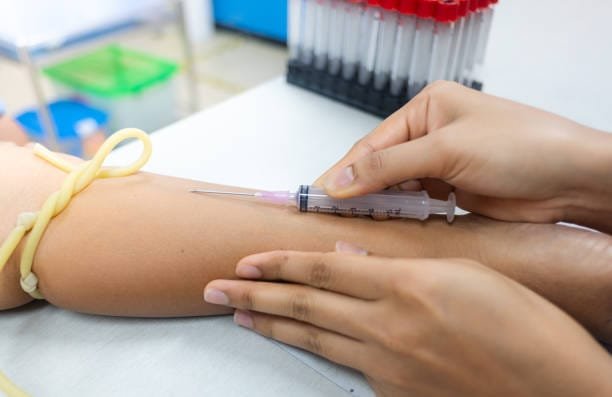Introduction

Typhoid fever is a fatal infection caused by Salmonella enterica serotype Typhi. The disease primarily affects the inhabitants of developing countries where most people live under poor sanitation and less access to clean water; however, the reported cases crop up everywhere in the world. Millions of reported cases are documented annually by the World Health Organization. Early detection and proper treatment will help avoid major complications. Here, we will discuss the cause, symptoms, treatment available, vaccines, duration, and preventive measures for typhoid fever.
Causes of Typhoid Fever
Typhoid fever is caused by the Salmonella Typhi bacteria, primarily through contaminated food and water. It can be occasionally transmitted directly from the feces of an infected person. Contamination usually occurs in places where the source of water and sanitation facilities are inadequate. The enteric bacteria may remain in water or sewer for weeks, making it quite easy to spread around if the water supply or food handling is not monitored properly.
The infection occurs after Salmonella typhi bacteria enter the body, usually through the mouth, after multiplying in the blood. Those who are carriers of the bacterium unknowingly spread the disease to others if proper hygiene steps like washing their hands thoroughly after using the toilet have not been carried out.
Typhoid Fever Symptoms:
Typhoid fever typically starts with mild signs and symptoms that can grow in severity if left untreated.
Symptoms usually develop within 6 to 30 days after exposure to the bacteria, but may include the following: Fever: High, prolonged fever (up to 104°F or 40°C) is the key symptom of typhoid. Headache: A constant headache is often severe. Abdominal pain and cramping: Pain usually worsens as the disease advances.
Weakness and Fatigue: The patient is usually weak and feels most lethargic, and it becomes difficult for him to accomplish his daily work.
Loss of Appetite with Weight Loss: Most people suffering from typhoid experience weight loss since many of them lose their appetite and have poor eating bits.
Diarrhea or Constipation: In some cases, the patient has severe diarrhea or the opposite extreme-severe constipation.
If not treated, these symptoms can be accompanied by intestinal bleeding or perforation that may be fatal. If not treated appropriately, typhoid fever can cause confusion or delirium and eventually septicemia, a blood infection that requires urgent medical attention.
Treatment for Typhoid Fever

Timely diagnosis is the key to successful treatment and recovery. Whenever typhoid fever is suspected, a doctor will usually request a blood test or stool test to confirm the presence of Salmonella hi. Treatment would also be mainly with antibiotics and supportive care.
antibiotics. The first-line treatment for typhoid fever is antibiotics, which kill Salmonella typhi bacteria. The most commonly employed drugs are ciprofloxacin, azithromycin, and ceftriaxone, though antibiotic resistance is growing, especially in areas with high endemicity of typhoid fever. Strains that are unresponsive to these commonly used drugs have been termed extensively drug-resistant (XDR) typhoid, and alternative treatments are frequently more expensive.
Hydration and Nutrition: Dehydration is the most common symptom in cases of typhoid due to fever and gastrointestinal signs. Patients should be encouraged to take plenty of fluids. Intravenous fluids should be administered if there is an absolute need for them. Proper nutrition is also to be followed up, as most patients show loss of weight and energy during illness.
Hospitalization: The condition may necessitate hospitalization for management if complications, like perforation of the intestines or continued high fever, arise. Patients who are hospitalized receive more intensive care, including fluid replacement and monitoring for any adverse developments.
Most patients start improving in a few days after receiving the antibiotics. However, it is important to complete the full course of the antibiotics to ensure all bacteria are completely eradicated and reduce the chances of one becoming a chronic carrier of the bacteria.
Vaccines for Typhoid Fever
Vaccination is an effective preventive measure against Typhoid fever, especially among populations living in or traveling to areas where typhoid is endemic. There are two basic types of vaccines.
Oral Typhoid Vaccine (Ty21a): This live-attenuated vaccine is given orally and requires several doses over a period of days. It confers immunity for around five years and may be administered to people over 6 years of age.
Injectable Typhoid Vaccine (Vi polysaccharide vaccine): This is an inactivated vaccine given parenterally; it confers protection up to 2 years and can be used in children older than 2 years of age.
A newer typhoid conjugate vaccine (TCV) has recently been introduced into some countries and has been shown to confer even longer immunity and can be administered to much younger children.
Duration and Recovery from Typhoid Fever
The duration of typhoid fever varies with the timeliness of treatment. When appropriate antibiotic therapy is administered, a typical improvement in symptoms usually starts in 3-5 days. However, full recovery may take weeks, and even after a long time, some patients can continue to feel ‘tired’ or ‘weak.’ In untreated cases, the symptoms may persist for several weeks and are more likely to have complications.
It is also that some people who recover from typhoid fever may still harbor the Salmonella typhi in their body and may go on to infect others. These people are called chronic carriers and may be treated with unique eradication measures.
Prevention of Typhoid Fever
Insofar as typhoid fever is concerned, prevention is the best remedy, especially for countries with meager healthcare equipment. The most effective ways to prevent typhoid fever are as follows:
Vaccination: People dwelling in risk-prone areas and those planning to travel into those areas should be immunized against typhoid to reduce their susceptibility.
Safe food and water: Only boiled or bottled water should be taken, while raw foods should be avoided because they are one of the primary routes used by pathogens. All foods should be well cooked, and good food hygiene practices should be applied to mainly those areas with poor sanitation.
Provisions for Sanitation and Hygiene: Hand washing with soap regularly, after visiting the toilet, and before meals should be emphasized. Studies have shown that improved sanitation through clean sources of water and waste management reduces the spread of the disease.
Avoid Contact with Infected People: If one knows that an individual has typhoid fever, avoid any close contact with him/her and ensure that such people have easy access to sanitation facilities.
Conclusion

Typhoid is a significant health disorder across the globe, especially in regions where there is poor sanitation. It is therefore essential to know the causative agents of this disease, its symptoms, and how it is treated to give an early diagnosis and thereby decrease morbidity and mortality due to complications. This seriously dangerous illness can be prevented through good hygiene practices combined with safe food and the use of vaccines.
Thus, the pressing measures initiated for the alleviation of the burden caused by typhoid fever around the globe will address issues related to antibiotic resistance, access to clean water, and sanitation infrastructure.



